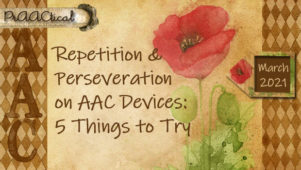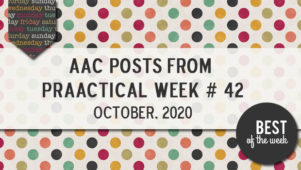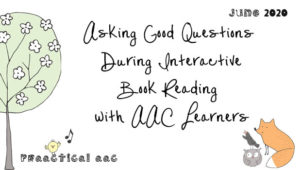Beyond Requesting: Thoughts on Teaching Interrogatives

.
A few weeks ago we talked about AAC intervention to teach someone how to convey information that others want or need. Giving instructions, answering comprehension questions, and retelling a story all fit into the Light’s category of ‘information transfer.’ Communicating in order to give information is only part of that story. Today, we complete the story by talking about getting information from others. Not all questions are about getting information, of course. We also ask questions for other reasons, like getting something we want or need (e.g., “May I have a drink, please?”) and socializing with friends/family (e.g., “How was your weekend?” “What did you do for your birthday?”). But in this post, we focus on interrogatives that serve the purpose of getting needed information from a communication partner. Many times when we think of interrogatives in language therapy, the focus is on answering them accurately and appropriately. The skill of asking questions in order to learn something sometimes gets shortchanged. Here are some of the things we think about when planning therapy sessions targeting this skill.
Authentic Communication Opportunities
Developing ‘good’ opportunities for the AAC user to learn how to ask questions is a lot tougher than it seems at first glance. Don’t be surprised if you struggle a bit there – we all do – but just keep at it. Until they have some pretty good pragmatic and language skills, AAC learners really need to develop this skill in a contextually relevant activity. What does that mean? It means that they need to learn to ask questions in situations where the response is really needed.
“Can I use board games to teach how to ask questions?”
Maybe. It depends on the communicator’s learning profile and on the game itself. Barrier games, like Guess Who, can be effective for this because each player needs information from the other person. On the other hand, games in which players have to create random WH questions in order to advance (e.g., draw a card with each turn; “Ask a when question”; “Find out your partner’s birthday”) may be less effective. Many learners do best when they acquire and practice new AAC skills in ‘real’ environments where they really need the information they are asking for. Others can manage more abstract and hypothetical (non-authentic) situations. Like any other clinical decision, knowledge of the communicator’s learning profile guides us.
It can be tricky to identify therapy activities in which the need for information is a real. Environmental arrangements or communication temptations can be used to develop those opportunities. Withholding some of the tools, ingredients, and materials needed for the activity, for example, helps the clinician create the ‘teachable moment’ in which question-asking skills can be taught. Some examples for activities in which participants really need the information they’re asking for are listed below.
| Context or Activity | Learner needs to ask things like: |
| Cooking (with visual supports) | What do we need? What’s next? How do we do it? Where is the ___? How many/much? How long? |
| Running errands on campus (e.g. delivering forms) | What do I need to do? Who is this for? Where do we need to go? When should I go? What time is it? When do you need it? What should I tell him/her? |
| Vocabulary collage | What should we do? Where are the (scissors/glue sticks/magazines/etc)? What is this? What does __ mean? |
| Character map | Who is it? What did he/she do? What is he/she like? Where did he/she go? Where does it say that? |
| Getting ready to go shopping | What do we need? Where will we go? How many/much? When are we going? Who is going? |
| Science activity, like sink/float trials or making slime | What do we need? What color? What do we do? How do we do it? Where is the ___? How many/much? |
What can SLPs do beyond creating those teachable moments? Here are some thoughts.
- Write goals to address this skill area. Some examples:
- Given an unfamiliar task, __ will ask for clarification and/or direction when steps in the process are unclear.
- __ will initiate questions about new events, changes in routines, or other novel occurrences at least twice/session.
- __ will ask relevant questions about reading, math, or science content using core word vocabulary at least once per class period.
- When engaged in conversation with a peer, __ will ask for relevant information.
- Following each session, __ will ask for scheduling, billing, or other information from familiar partners.
- Make the goals overt: Our clients should know what we are trying to get them to achieve. We all do better when we know where the target is. Think back to your days as a grad student SLP. Remember those professors who gave you a rubric to let you know how your research paper would be graded? Remember the ones who didn’t? Chances are, you felt more comfortable and attained a better outcome when you had clear guidance as to what your professor was looking for. Our clients are no different. Make the goals clear. For some clients, I develop visual supports showing the goals and review those prior to the start of each session. Then we refer back to the goal list when needed throughout the session.
- Use patterns whenever possible: Like other sentence forms, interrogatives have specific patterns (E.g., Is he/she __? Do we __ ? Where is the __? When do I __? How much is __?). Humans are pattern-seekers and learning is hastened when there are overt patterns. For some learners, adding visual supports can help make the patterns really clear.
- Model the desired behavior: Model whatever question-asking behavior you have as the goal. An observer should know what specific kind of questioning you are working on by the sheer number of times he/she hears you use that type of question in your interaction with the person who uses AAC.
- Use aided language input. If you wanted to learn how to ask where to go in Norwegian, wouldn’t you learn best by hearing others ask that same question in Norwegian. To teach AAC, speak AAC.
- Provide instructive feedback: When the AAC learner doesn’t respond as you had hoped, provide support by giving them the information he/she needs to succeed. Success? Yay! Follow it up with specific reinforcement, and/or an expansion/elaboration. (Comments like ‘Good asking’ aren’t specific enough. They may be helpful for learners who have mastered the skill but don’t use it frequently. Everyone else needs more specific reinforcement in order to maximize their learning.)
- Ensure frequent opportunities for practice: Emerging skills are flimsy. Practice strengthens them, but it can be hard to provide enough practice in the context of a therapy session. Get others on board. If they can’t provide practice opportunities, see if you can at least get them to model the target interrogative during their time with the learner.
Teaching AAC learners to get information using a variety of interrogative forms takes planning and creativity, but that’s nothing new to SLPs. If you have a favorite strategy or activity for teaching questions, we’d love to hear about it.
Filed under: Strategy of the Month
Tagged With: beyond requesting, interrogatives, language therapy, questions
This post was written by Carole Zangari





2 Comments
Great post (as always) Carole!
I developed an app that targets this skill specifically called Asking Therapy. It breaks down each interrogative type (wh and yes/no) to provide situations that encourage inquisitiveness. In one activity, part of a message has been cut off, and the user must ask to find out what they missed. In another, the user has to form a question to get the info they want to know.
It’s for older students and adults, and it has a free trial called Question Therapy Lite (paired with an answering questions app). Thought your readers might like to try it out!
thanks so much